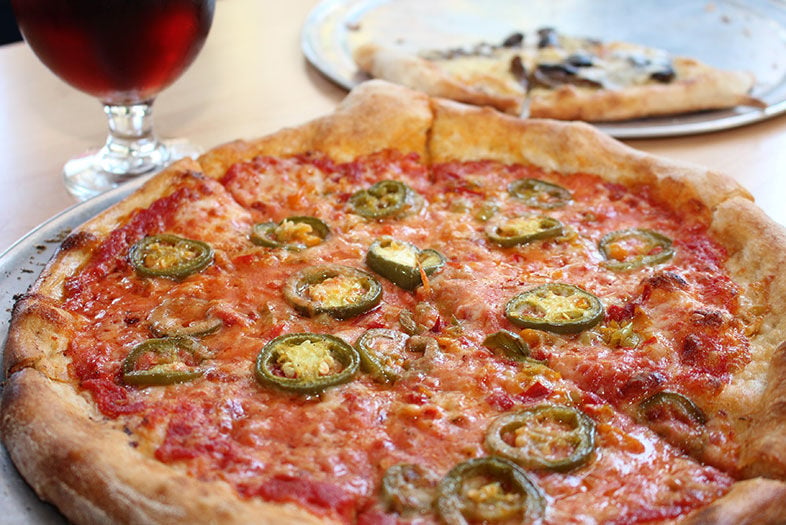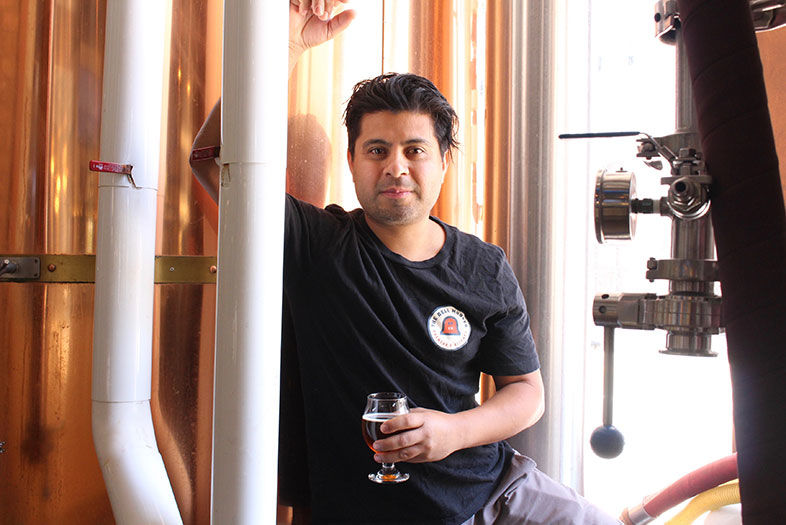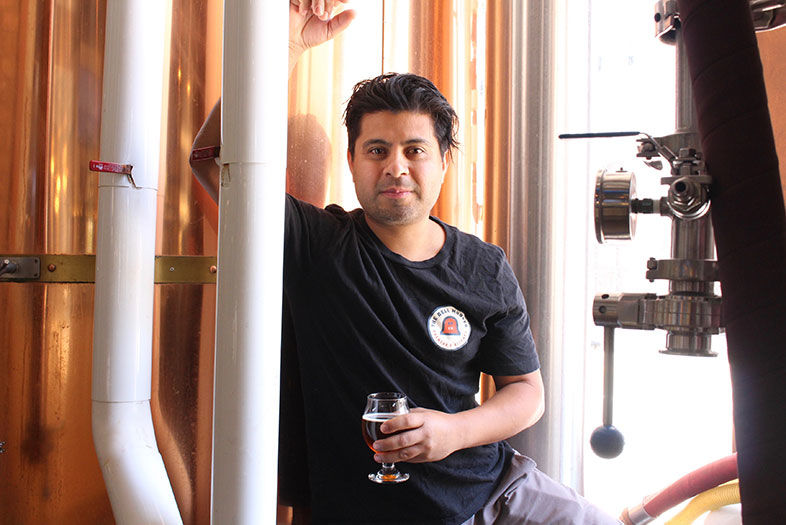It’s amazing what a difference a brewer makes. Previously, when this Broadway location was The Beer Company, the brewer made a decent-sized lineup of rather “meh” beers that were fine with food, but nothing memorable. Now, on the very same system in the exact same space, the beers have suddenly begun to shine. What’s the difference? Nacho Cervantes is brewing there.
When new management took over this space and turned it into a Bell Marker brewpub, they revamped the food menu (they now have great pizza and lots of veggie and vegan options) and ramped up the beer quality by hiring one of San Diego’s most experienced brewers. Beer lovers in downtown should be cheering—this improves the urban beer landscape significantly (not that it’s bad, it’s just small) and it helps to make downtown a decent beer destination by adding to what has become a notable enclave of good breweries.
I sat down with Nacho to talk about his recent transition and what it’s like to now be part of the downtown scene. As I sipped on a light but super delicious Cream Ale (just out of the tank!), I also asked him about his years at Pizza Port and what he’s most looking forward to in his new job.
When was your official starting date here at Bell Marker?
I started on March 15.
And you came from Pizza Port Bressi, right?
Yeah. March 9 was my last day there.
And before that, it was Pizza Port OB.
Right. I actually started in Solana Beach, then went to Carlsbad, where I started working on the brew side—that was when they had just opened Port Brewing/Lost Abbey—so I would also have to go over there and help out. All our keg washing was done at Lost Abbey. I used to have to drive them all the way over there, wash them, and then drive them all the way back to Carlsbad!
So, how long were you at Pizza Port all together?
Fifteen years.
And that was your first brew job?
Yup. I learned everything there. Before that, I knew about craft beer, but not as much as I learned once I started working there.
Who were you brewing under originally at Pizza Port?
Jeff Bagby. When I first started at Solana, Tomme [Arthur] was still there—I used to barback for him when he was bartending—but he left soon after to open Lost Abbey. He and Jeff had asked me a couple of times back then if I wanted to help out and I said no. I didn’t want to touch that equipment! But then I decided to try it out.
Thinking back on your time there, what would say are the things you learned from Bagby—or from working at Pizza Port—that stick out in your mind the most?
Attention to detail and being consistent. He was really strict about that.
How about on the recipe side? What was the attitude about doing new recipes or building a recipe?
He was pretty open minded. He was really good about teaching us about ingredients.

Have a Beer with The Bell Marker’s Head Brewer Nacho Cervantes
More than 16 house beers are available on tap at The Bell Marker. | Photo: Bruce Glassman
You kind of went from a medium-small system to a really big system at Bressi and now you’re back on a medium-small system.
It’s the same size system I started on in Carlsbad; 15 barrel. I’m definitely used to this size and I’m very familiar with coming up with recipes for this size system.
You’re pretty much working on your own here at this point, yes?
So far, yes. But the idea is to eventually find an assistant down the line. For now, I’m pretty comfortable just doing it on my own.
Would you say that’s where you’re happiest, working on your own? As opposed to the big team and managing lots of people?
I wouldn’t say it makes me the happiest. I’m usually a pretty quiet, reserved person to start with, so I don’t mind being on my own, but there are times I do wish I had some help. I do miss the ability to count on someone else, especially if I can’t be here.
So what are some of the other major differences between where you were and where you are now?
At Bressi, the brewhouse is all closed off to the public, so it took me a little while to get used to interacting with the customers and the [front of house] staff again. I also had to get used to people watching me here as I was brewing. You feel people staring at you sometimes!
Do you get people coming up and asking questions a lot?
Sometimes.
What’s the dumbest question you’ve gotten so far?
“What is this?” [Meaning the brew house and the tanks.] I get that a lot. “What does this do?” And I say, “I’m making beer,” and they say, “Oh, really?!” I also get a lot of real beer questions, too. Like people who are beer savvy or people who have a system of their own.
You have a pretty extensive variety of house-brewed beers here. What’s your overall strategy for what to brew?
Well, when I first started here, they had a few house IPAs that they were about to run out of, so, at first, I said maybe I should do a bunch of hoppy beers. So I made a house IPA. And that first (California ale) yeast strain worked wonders. It just kept going; it was really healthy, so I figured I might as well just make another one. So I did about five or six hoppy beers right off the bat. Then I thought I want to play around and try some other things. That’s when I made the American Brown. I made it with the same strain as the hoppy beers, which I had always wanted to do. At Pizza Port we always used the English strain for the brown, so this was my chance.
What did the Cali ale yeast do to the brown that was different from the English?
I felt like the California strain brings out the hops a lot more. I mean, with that kind of recipe, you’re going to have a lot of malt character, but I thought this strain helped to pop up the hoppiness.
What are some of the other things you’re looking forward to doing over here with this program?
I’ve been doing a bunch of research. I’ve always been a big fan of the Hitachino Nest Red Rice Ale [a Belgian Strong Pale Ale Style brewed in Japan by Kiuchi Brewery] and I really want to try to attempt that here. I was considering blending some yeast strains for that one. I was thinking of getting a sake yeast strain for it as well.
And you put rice in the grain bill, right?
Yup. But you have to get the right variety and clean it up—it’s this whole big process. It’s almost a step-batch process, which I wouldn’t be able to do here, so I’ll have to figure out a way to pull it off on this equipment.
How about kettle sours?
I’ve thought about it, but looking at how the system’s set up, I’m not sure how safe it would be to make a kettle sour here. You have to re-pressurize your kettle to do it and it’s not really well ventilated in this space, so I would be a little hesitant about it. I told myself I was going to wait a little while, get a little more comfortable with the system, and then see if I can figure out an approach. Right now, I don’t think it’s the safest beer to make.

Have a Beer with The Bell Marker’s Head Brewer Nacho Cervantes
Bell Marker’s new menu includes numerous vegan and vegetarian options and great thin-crust pizzas. | Photo: Bruce Glassman
Do you have room for any barrels here?
I’ve been talking about it with the general manager. It’s definitely something I’d like to do and plan to do, I just have to figure out the space.
You have a long history in the brewing community here in San Diego, lots of long-term relationships. Are you planning to do some collaborations with a bunch of your colleagues?
I definitely have some in the works, I have a lot of friends in the industry and I would love to work with all of them. There are also a lot of exciting new breweries out there that I’d like to go and visit and make acquaintances at. We also have a project here where we try to do collabs with our employees and with local businesses nearby. We want to try to do that every month or every other month. We did one with Mering Carson, a local ad agency right here.
How did that work exactly, collaboration-wise?
They had a few employees who were big fans of craft beer, so they sent them in. We talked about beers and what we liked and what they’d like to have here to drink. Half of them wanted something big and hoppy, and the other half wanted something fruity, so we created Peachside Pale Ale, which has flavors of peaches and kumquats. We really enjoyed the collaborations and eventually we want to offer the collaboration opportunity to our regulars as well, to show them our appreciation.
You’ve been part of the San Diego brewing scene for fifteen years. When you first started there were—what?—eight breweries in town?
It was just a handful. I remember the first couple of festivals I would go to, it was always the same small group of people.
So what does it feel like now for you? It must feel totally weird to have so many breweries around.
It’s kind of surreal, to see what it’s become. Especially remembering how it was back then. I think it’s a great thing, though.
There are 134 breweries right now. There must be at least half of them that you haven’t even visited yet, right?
Yeah. Unfortunately, I kind of lost track after a while. Fortunately, we do carry some guest beers here, so I get to taste some of those.
Who are some of the new guys that you’ve tasted that you’d say are notable for you?
Well, Burgeon. I was able to hang out with them and have a lot of their beers while I was working at Bressi. They’re just down the road. Fall I’m a big fan of. And the Three Punk guys are cool, as well as Chula Vista Brewing. The South Bay scene is really picking up there, which is great. Here, in the downtown, Half Door is doing great stuff and Resident is doing awesome stuff. And, of course, Karl Strauss is still a great place. I’m hoping that more people will start coming downtown for craft beer. We’ve got a little more variety now and we even have a trolley station right nearby, so you can drink all the beer you want and then get on the trolley!
Follow Bruce:

Have a Beer with The Bell Marker’s Head Brewer Nacho Cervantes
PARTNER CONTENT
Nacho Cervantes is now the head brewer for The Bell Marker Brewery & Kitchen downtown. | Photo: Bruce Glassman

















